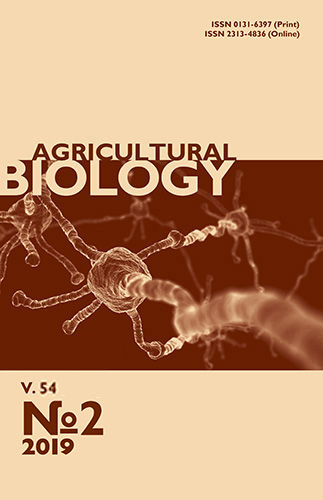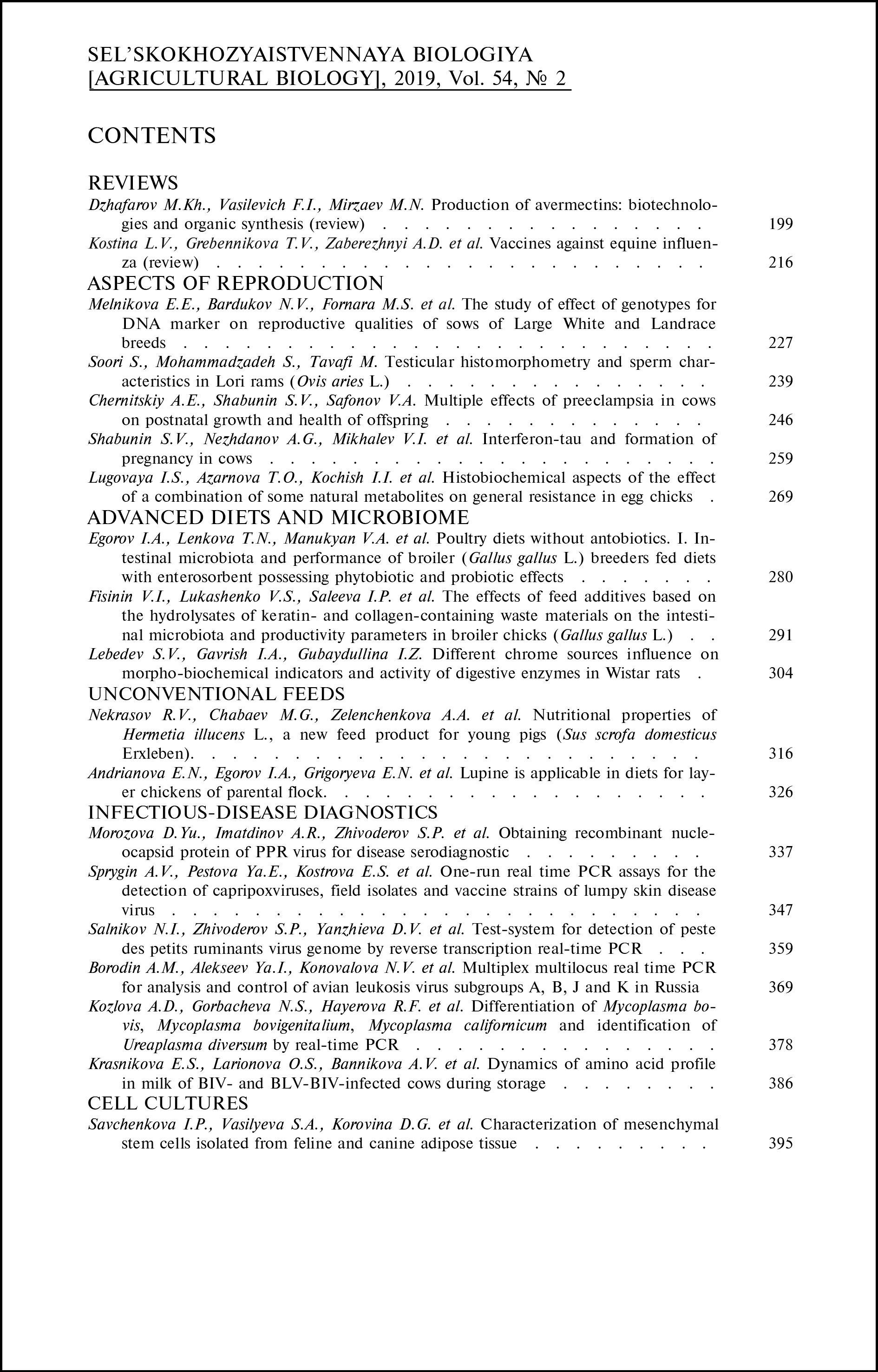doi: 10.15389/agrobiology.2019.2.386eng
UDC: 636.2:619:57.088.1
DYNAMICS OF AMINO ACID PROFILE IN MILK OF BIV- AND BLV-BIV-INFECTED COWS DURING STORAGE
E.S. Krasnikova, O.S. Larionova, A.V. Bannikova, A.V. Evteev, G.Kh. Utanova
Vavilov Saratov State Agrarian University, Department of Microbiology, Biotechnology and Chemistry, 1, Teatralnaya pl., Saratov, 410012 Russia, e-mail krasnikovaes77@yandex.ru (✉ corresponding author), larionova1@mail.ru, annbannikova@gmail.com, ewteew@gmail.com, sgau.microb@list.ru
ORCID:
Krasnikova E.S. orcid.org/0000-0003-4395-5862
Evteev A.V. orcid.org/0000-0002-6155-3851
Larionova O.S. orcid.org/0000-0001-5457-0306
Utanova G.Kh. orcid.org/0000-0002-6659-0483
Bannikova A.V. orcid.org/0000-0002-5582-0394
Received December 20, 2018
Leukemia and viral immunodeficiency of cattle rank to the number of difficult diagnosed infections of farm animals which increases the probability of virus carrying. At present time there are no legislative approved standards for bovine immunodeficiency diagnosis so the milk from sick cows can infect bulk milk obtained from healthy animals. Frequently bovine immunodeficiency virus (BIV) is detected in animals infected by bovine leukemia virus (BLV). The present work reveals that milk of cows infected by retroviruses has an altered amino acid balance of the casein fraction, as well as lower protein stability when stored in a refrigerator. The aim of our research was to assay the amino acid composition and evaluate its stability in milk of BIV-infected and BLV-BIV-co-infected cows, as compared to milk of healthy animals. A total of 6 samples of pure cow milk obtained from 2.8-6.7-year old black-and-white dairy cows infected by bovine immunodeficiency virus (n = 3) and cows with BLV-BIV coinfection (n = 3) were tested. BIV and BLV-BIV infection was approved by PCR tests. Analysis of amino acid composition of the protein fraction was performed using a capillary electrophoresis system Capel 105M (LLC “Lumex-Marketing”, Russia). Milk was tested on day 1, day 3 and day 6 of storage at 4 °С. The standard data on the amino acid balance of the casein fraction of healthy cows’ milk was used for the comparative analysis. Our results indicate that milk from BIV and BLV-BIV infected cows differs significantly in amino acid composition from healthy cows’ milk. We consider the milk casein fraction to be more illustrative because casein is the main milk protein and its amino acid profile in not changed even under hydrolysis. The weight percentage of the essential and conditionally essential amino acids such as methionine, glutamine, histidine and glycine in infected milk reduces 3-4-fold. The content of arginine, lysine, proline and asparagine are similar to normal, tyrosine is passed into the limiting position under a deficient phenylalanine which content is 6 times lower than normal. There was a comparative excess amount of threonine and serine. The weight percentage of lysine, valine, leucine-isoleucine and glutamine is 9, 13, 17.5 and 22 times lower that in healthy cows’ milk. The leucine-isoleucine and valine ratio of infected milk is approximately 1:1 whereas it amounts to 2.5:1 in healthy cows’ milk. It was observed that milk of BIV and BLV-BIV infected cows is characterized by expressed dynamic of amino acid profiles during storage in a refrigerator. The essential amino acids arginine, histidine and methionine were not detected in the milk of infected cows on the sixth day of the storage in the refrigerator. The weight percentage of tyrosine increased on day 3 and decreased on day 6 of storage. Moreover, these parameters were significantly changed in BIV infected milk. The weight percentage of phenylalanine, leucine-isoleucine, valine, serine and glycine in BIV and BLV-BIV infected milk increased on day 6 of storage by 27.1 and 2.4 %; 22.3 and 8.9 %; 43.9 and 37.2 %; 25.0 and 27.3 %, and 0 and 60 %. The weight percentage of proline and threonine reduced on day 6 of storage by 10.6 and 13.7 %; 5.3 and 0 %. The weight percentage of alanine on day 6 in BIV infected milk increased by 37.5 % but in BLV-BIV infected milk reduced by 17.8 %. The imbalance and instability of amino acid profile of BLV and BLV-BIV infected milk prove are indicative of development of uncontrolled processes.
Keywords: cow’s milk, milk protein, amino acids, immunodeficiency virus, leukemia.
REFERENCES
- Ovsyannikova O.V., Ksenz M.V. Sfera uslug: innovatsii i kachestvo, 2012, 7: 30-43 (in Russ.).
- Teunissen-Beekman K.F., Dopheide J., Geleijnse J.M., Bakker S.J., Brink E.J., de Leeuw P.W., van Baak M.A. Effect of increased protein intake on renal acid load and renal hemodynamic responses. Physiological Reports, 2016, 4(5): e12687 CrossRef
- Wu G. Dietary protein intake and human health. Food & Function, 2016, 7: 1251-1265 CrossRef
- McGregor R.A., Poppitt S.D. Milk protein for improved metabolic health: a review of the evidence. Nutrition & Metabolism, 2013, 10: 46 CrossRef
- Saubade F., Hemery Y.M., Guyot J.P., Humblot C. Lactic acid fermentation as a tool for increasing the folate content of foods. Critical Reviews in Food Science and Nutrition, 2017, 57(18): 3894-3910 CrossRef
- Savilahti E. Probiotics in the treatment and prevention of allergies in children. Bioscience and Microflora, 2011, 30(4): 119-128 CrossRef
- Ricci-Cabello I., Herrera M.O., Artacho R. Possible role of milk-derived bioactive peptides in the treatment and prevention of metabolic syndrome. Nutrition Reviews, 2012, 70(4): 241-255 CrossRef
- Heine W.E. Protein source and microflora. In: Probiotics, other nutritional factors, and intestinal microflora. 2nd Nestle Nutrition Workshop, Beijing, China, May 1997. N.A. Hanson, R.H. Yolken (eds.). Philadelphia, Lippincott-Raven, 1999: 175-188.
- Caldow M.K., Digby M.R., Cameron-Smith D. Short communication: Bovine-derived proteins activate STAT3 in human skeletal muscle in vitro. Journal of Dairy Science, 2015, 98(5): 3016-3019 CrossRef
- Hagi T., Sasaki K., Aso H., Nomura M. Adhesive properties of predominant bacteria in raw cow's milk to bovine mammary gland epithelial cells. Folia Microbiologica, 2013, 58(6): 515-522 CrossRef
- Gorbatova K.K., Gun'kova P.I. Khimiya i fizika moloka i molochnykh produktov [Chemistry and physics of milk and dairy products]. Moscow, 2012 (in Russ.).
- Wu G. Amino acids: metabolism, functions, and nutrition. Amino Acids, 2009, 37(1): 1-17 CrossRef
- Yang Y., Fan W., Mao Y., Yang Z., Lu G., Zhang R., Zhang H., Szeto C., Wang C. Bovine leukemia virus infection in cattle of China: Association with reduced milk production and increased somatic cell score. Journal of Dairy Science, 2016, 99(5): 3688-3697 CrossRef
- Bauermann F.V., Ridpath J.F., Dargatz D.A. Bovine leukemia virus seroprevalence among cattle presented for slaughter in the United States. Journal of Veterinary Diagnostic Investigation, 2017, 29(5): 704-706 CrossRef
- Schnell S.A., Ohtsuka H., Kakinuma S., Yoshikawa Y., Watanabe K., Orino K. Iron and ferritin levels in the serum and milk of bovine leukemia virus-infected dairy cows. Front. Vet. Sci., 2015, 2: 12 CrossRef
- Krasnikova E.S., Utanova G.Kh., Fedosov N.A., Shcherbakov A.A. Nauchnoe obozrenie, 2015, 17: 10-15 (in Russ.).
- Della Libera A.M., de Souza F.N., Batista C.F., Santos B.P., de Azevedo L.F., Sanchez E.M., Diniz S.A., Silva M.X., Haddad J.P., Blagitz M.G. Effects of bovine leukemia virus infection on milk neutrophil function and the milk lymphocyte profile. Veterinary Research, 2015, 46: 2 CrossRef
- Zakrepina E.N. Leikoz krupnogo rogatogo kota i ego vliyanie na kolichestvennye i kachestvennye pokazateli molochnoi produktivnosti korov. Avtoreferat kandidatskoi dissertatsii [Cattle leukemia and its impact on the quantitative and qualitative indicators of cow’s milk production. PhD Thesis]. Vologda-Molochnoe, 2001 (in Russ.).
- Brujeni G.N., Poorbazargani T.T., Nadin-Davis S., Tolooie M., Barjesteh N. Bovine immunodeficiency virus and bovine leukemia virus and their mixed infection in Iranian Holstein cattle. J. Infect. Dev. Ctries, 2010, 4(9): 576-579 CrossRef
- Bhatia S., Patil S.S., Sood R. Bovine immunodeficiency virus: a lentiviral infection. Indian Journal of Virology, 2013, 24(3): 332-341 CrossRef
- Barkova A.S., Kolchina A.F., Barashkin M.I., Loretts O.G., Tarasenko M.N. Aminokislotnyi sostav moloka korov cherno-pestroi porody. Materialy VII Mezhdunarodnoi nauchno-prakticheskoi konferentsii «Obrazovanieto i naukata na XXI vek — 2012» [Proc. VII Int. Сonf. «Education and Science in XXI century-2012»]. Sofiya, 2012: 95-100 (in Russ.).
- Nadtochii L.A., Orlova O.Yu. Innovatsii v biotekhnologii. Chast’. 2. Pishchevaya kombinatorika [Innovations in biotechnology. Part 2. Food combinatorics]. St. Petersburg, 2015: 8 (in Russ.).
- Yu X., Long Y.C. Autophagy modulates amino acid signaling network in myotubes: differential effects on mTORC1 pathway and the integrated stress response. FASEB J., 2015, 29(2): 394-407 CrossRef
- Wu G. Dietary requirements of synthesizable amino acids by animals: a paradigm shift in protein nutrition. Journal of Animal Science and Biotechnology, 2014, 5(1): 34 CrossRef
- Wu G. Functional amino acids in growth, reproduction, and health. Advances in Nutrition, 2010, 1(1): 31-37 CrossRef
- Ianni F., Sardella R., Lisanti A., Gioiello A., Cenci Goga B.T., Lindner W., Natalini B. Achiral-chiral two-dimensional chromatography of free amino acids in milk: a promising tool for detecting different levels of mastitis in cows. J. Pharm. Biomed. Anal., 2015, 116: 40-46 CrossRef
- Bochniarz M., Kocki T., Dąbrowski R., Szczubiał M., Wawron W., Turski W.A. Tryptophan, kynurenine, kynurenic acid concentrations and indoleamine 2,3-dioxygenase activity in serum and milk of dairy cows with subclinical mastitis caused by coagulase-negative staphylococci. Reprod. Domest. Anim., 2018, 53(6): 1491-1497 CrossRef












